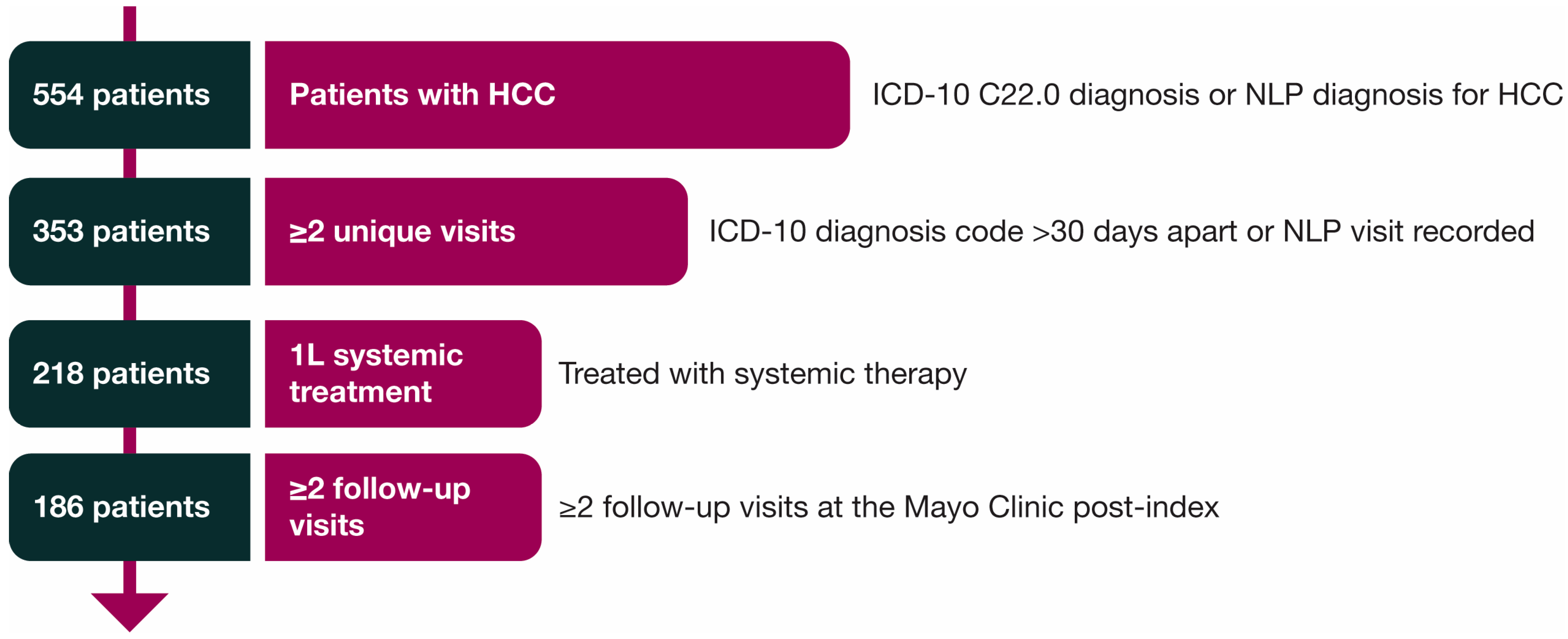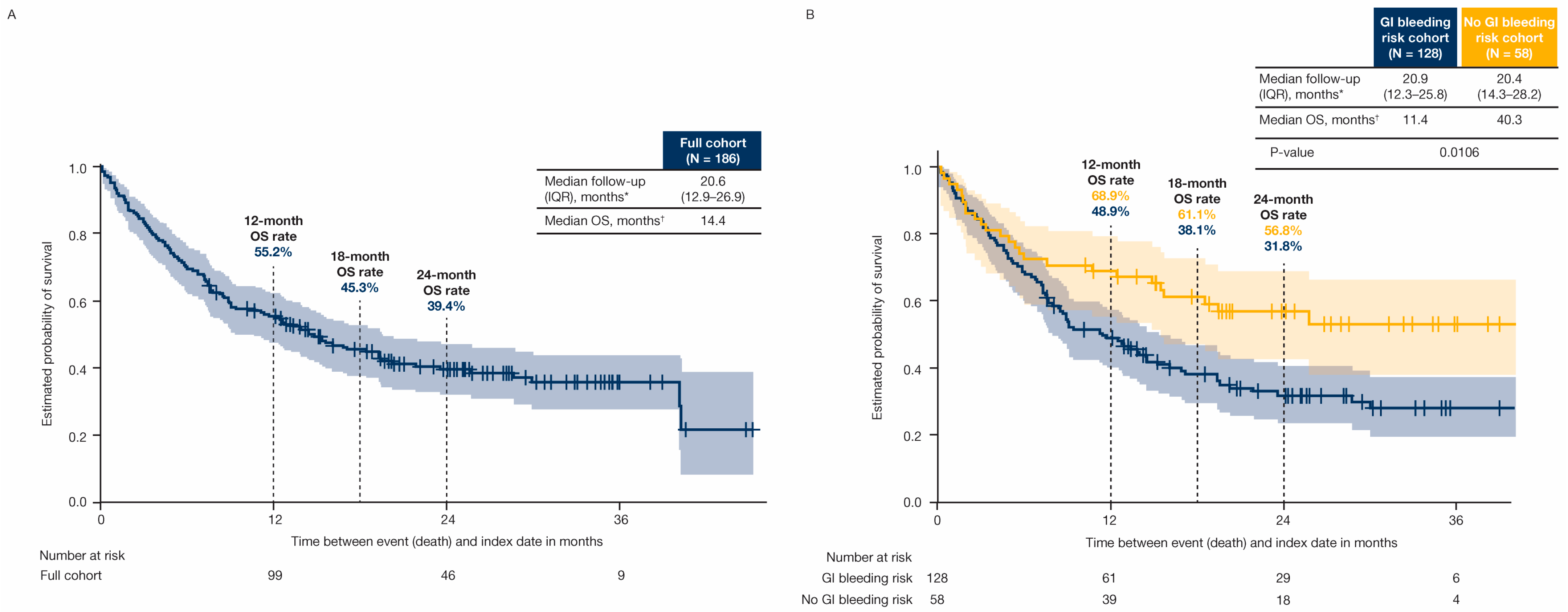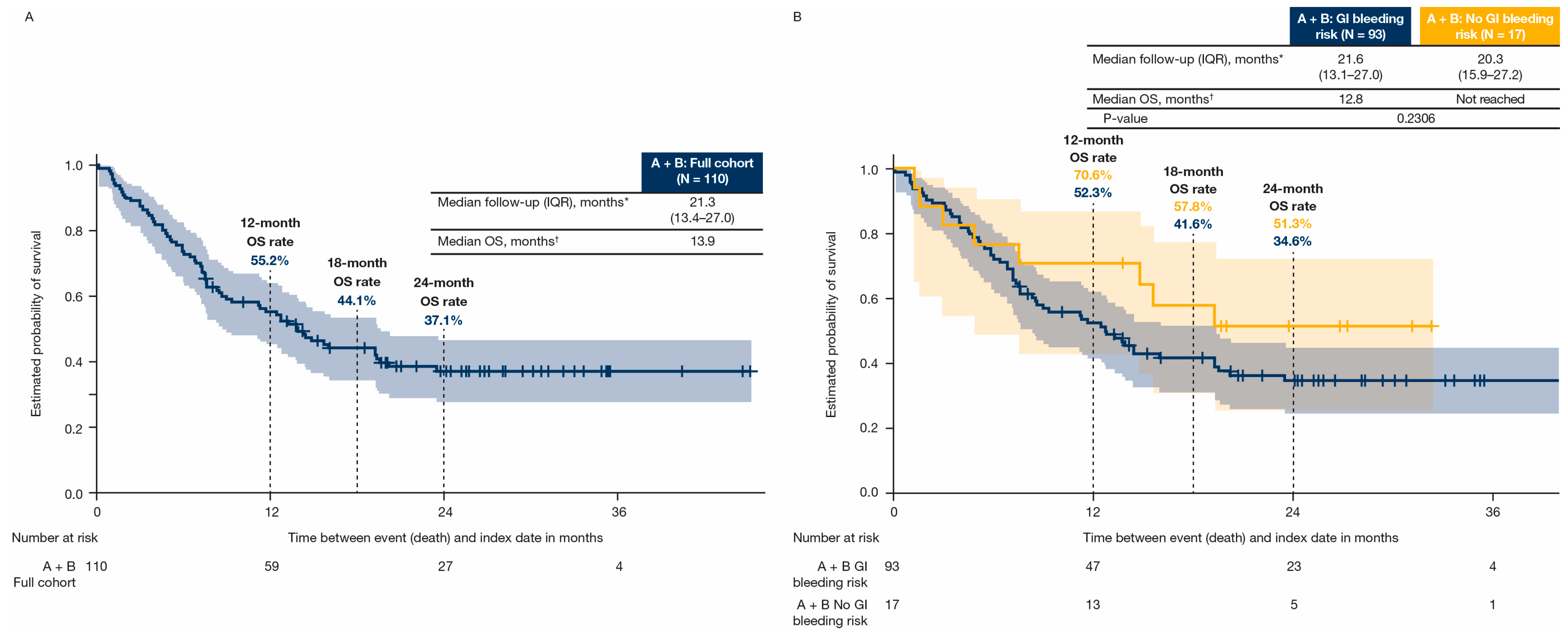Patient Characteristics, Treatment Patterns, and Outcomes in Unresectable Hepatocellular Carcinoma Treated with First-Line Systemic Therapy in the United States
Simple Summary
Abstract
1. Introduction
2. Materials and Methods
2.1. Data Source
2.2. Study Population
2.3. Study Variables
2.4. Statistical Analyses
3. Results
3.1. Patient Characteristics
3.2. Treatment Patterns
3.3. Overall Survival
3.4. Post-Index GI Bleeding
4. Discussion
5. Conclusions
Author Contributions
Funding
Institutional Review Board Statement
Informed Consent Statement
Data Availability Statement
Acknowledgments
Conflicts of Interest
References
- Bray, F.; Laversanne, M.; Sung, H.; Ferlay, J.; Siegel, R.L.; Soerjomataram, I.; Jemal, A. Global cancer statistics 2022: GLOBOCAN estimates of incidence and mortality worldwide for 36 cancers in 185 countries. CA Cancer J. Clin. 2024, 74, 229–263. [Google Scholar] [CrossRef]
- Choi, D.T.; Kum, H.C.; Park, S.; Ohsfeldt, R.L.; Shen, Y.; Parikh, N.D.; Singal, A.G. Hepatocellular carcinoma screening is associated with increased survival of patients with cirrhosis. Clin. Gastroenterol. Hepatol. 2019, 17, 976–987.e4. [Google Scholar] [CrossRef]
- Siegel, R.L.; Kratzer, T.B.; Giaquinto, A.N.; Sung, H.; Jemal, A. Cancer statistics, 2025. CA Cancer J. Clin. 2025, 75, 10–45. [Google Scholar] [CrossRef]
- Petrick, J.L.; Kelly, S.P.; Altekruse, S.F.; McGlynn, K.A.; Rosenberg, P.S. Future of hepatocellular carcinoma incidence in the United States forecast through 2030. J. Clin. Oncol. 2016, 34, 1787–1794. [Google Scholar] [CrossRef]
- Singal, A.G.; Llovet, J.M.; Yarchoan, M.; Mehta, N.; Heimbach, J.K.; Dawson, L.A.; Jou, J.H.; Kulik, L.M.; Agopian, V.G.; Marrero, J.A.; et al. AASLD practice guidance on prevention, diagnosis, and treatment of hepatocellular carcinoma. Hepatology 2023, 78, 1922–1965. [Google Scholar] [CrossRef] [PubMed]
- Finn, R.S.; Qin, S.; Ikeda, M.; Galle, P.R.; Ducreux, M.; Kim, T.Y.; Kudo, M.; Breder, V.; Merle, P.; Kaseb, A.O.; et al. Atezolizumab plus bevacizumab in unresectable hepatocellular carcinoma. N. Engl. J. Med. 2020, 382, 1894–1905. [Google Scholar] [CrossRef]
- US Food and Drug Administration. FDA Approves Atezolizumab Plus Bevacizumab for Unresectable Hepatocellular Carcinoma. 1 June 2020. Available online: https://www.fda.gov/drugs/drug-approvals-and-databases/fda-approves-atezolizumab-plus-bevacizumab-unresectable-hepatocellular-carcinoma (accessed on 23 July 2025).
- Abou-Alfa, G.K.; Lau, G.; Kudo, M.; Chan, S.L.; Kelley, R.K.; Furuse, J.; Sukeepaisarnjaroen, W.; Kang, Y.K.; Van Dao, T.; De Toni, E.N.; et al. Tremelimumab plus durvalumab in unresectable hepatocellular carcinoma. NEJM Evid. 2022, 1, EVIDoa2100070. [Google Scholar] [CrossRef] [PubMed]
- US Food and Drug Administration. FDA Approves Tremelimumab in Combination with Durvalumab for Unresectable Hepatocellular Carcinoma. 24 October 2022. Available online: https://www.fda.gov/drugs/resources-information-approved-drugs/fda-approves-tremelimumab-combination-durvalumab-unresectable-hepatocellular-carcinoma (accessed on 2 June 2025).
- US Food and Drug Administration. FDA Approves Nivolumab with Ipilimumab for Unresectable or Metastatic Hepatocellular Carcinoma. 11 November 2025. Available online: https://www.fda.gov/drugs/resources-information-approved-drugs/fda-approves-nivolumab-ipilimumab-unresectable-or-metastatic-hepatocellular-carcinoma (accessed on 16 June 2025).
- Galle, P.R.; Decaens, T.; Kudo, M.; Qin, S.; Fonseca, L.; Sangro, B.; Karachiwala, H.; Park, J.-W.; Gane, E.; Pinter, M.; et al. Nivolumab (NIVO) plus ipilimumab (IPI) vs lenvatinib (LEN) or sorafenib (SOR) as first-line treatment for unresectable hepatocellular carcinoma (uHCC): First results from CheckMate 9DW. J. Clin. Oncol. 2024, 42, LBA4008. [Google Scholar] [CrossRef]
- Yau, T.; Galle, P.R.; Decaens, T.; Sangro, B.; Qin, S.; da Fonseca, L.G.; Karachiwala, H.; Blanc, J.-F.; Park, J.-W.; Gane, E.; et al. Nivolumab plus ipilimumab versus lenvatinib or sorafenib as first-line treatment for unresectable hepatocellular carcinoma (CheckMate 9DW): An open-label, randomised, phase 3 trial. Lancet 2025, 405, 1851–1864. [Google Scholar] [CrossRef]
- Vogel, A.; Chan, S.L.; Ren, Z.; Bai, Y.; Gu, S.; Lin, X.; Chen, Z.; Jia, W.; Jin, Y.; Guo, Y.; et al. Camrelizumab plus rivoceranib vs sorafenib as first-line therapy for unresectable hepatocellular carcinoma (uHCC): Final overall survival analysis of the phase 3 CARES-310 study. J. Clin. Oncol. 2024, 42, 4110. [Google Scholar] [CrossRef]
- Llovet, J.M.; Kudo, M.; Merle, P.; Meyer, T.; Qin, S.; Ikeda, M.; Xu, R.; Edeline, J.; Ryoo, B.-Y.; Ren, Z.; et al. Lenvatinib plus pembrolizumab versus lenvatinib plus placebo for advanced hepatocellular carcinoma (LEAP-002): A randomised, double-blind, phase 3 trial. Lancet Oncol. 2023, 24, 1399–1410. [Google Scholar] [CrossRef]
- Kelley, R.K.; Rimassa, L.; Cheng, A.-L.; Kaseb, A.; Qin, S.; Zhu, A.X.; Chan, S.L.; Melkadze, T.; Sukeepaisarnjaroen, W.; Breder, V.; et al. Cabozantinib plus atezolizumab versus sorafenib for advanced hepatocellular carcinoma (COSMIC-312): A multicentre, open-label, randomised, phase 3 trial. Lancet Oncol. 2022, 23, 995–1008. [Google Scholar] [CrossRef]
- de Mattos, A.Z.; Bombassaro, I.Z.; Vogel, A.; Debes, J.D. Hepatocellular carcinoma-the role of the underlying liver disease in clinical practice. World J. Gastroenterol. 2024, 30, 2488–2495. [Google Scholar] [CrossRef] [PubMed]
- De Gaetano, V.; Pallozzi, M.; Cerrito, L.; Santopaolo, F.; Stella, L.; Gasbarrini, A.; Ponziani, F.R. Management of portal hypertension in patients with hepatocellular carcinoma on systemic treatment: Current evidence and future perspectives. Cancers 2024, 16, 1388. [Google Scholar] [CrossRef] [PubMed]
- Song, Y.G.; Yeom, K.M.; Jung, E.A.; Kim, S.G.; Kim, Y.S.; Yoo, J.J. Risk of bleeding in hepatocellular carcinoma patients treated with atezolizumab/bevacizumab: A systematic review and meta-analysis. Liver Cancer 2024, 13, 590–600. [Google Scholar] [CrossRef] [PubMed]
- Duffy, A.; Wilkerson, J.; Greten, T.F. Hemorrhagic events in hepatocellular carcinoma patients treated with antiangiogenic therapies. Hepatology 2013, 57, 1068–1077. [Google Scholar] [CrossRef]
- Kaplan, D.E.; Dai, F.; Aytaman, A.; Baytarian, M.; Fox, R.; Hunt, K.; Knott, A.; Pedrosa, M.; Pocha, C.; Mehta, R.; et al. Development and performance of an algorithm to estimate the Child-Turcotte-Pugh score from a national electronic healthcare database. Clin. Gastroenterol. Hepatol. 2015, 13, 2333–2341.e6. [Google Scholar] [CrossRef]
- Rinella, M.E.; Lazarus, J.V.; Ratziu, V.; Francque, S.M.; Sanyal, A.J.; Kanwal, F.; Romero, D.; Abdelmalek, M.F.; Anstee, Q.M.; Arab, J.P.; et al. A multisociety Delphi consensus statement on new fatty liver disease nomenclature. Hepatology 2023, 78, 1966–1986. [Google Scholar] [CrossRef]
- Klink, A.J.; Marshall, L.Z.; Aly, A.; Seal, B.; Healey, M.J.; Feinberg, B. Real-world treatment patterns and reasons for therapy selection in patients with advanced hepatocellular carcinoma in US oncology practices. Oncologist 2022, 27, e265–e272. [Google Scholar] [CrossRef]
- Kasmari, A.J.; Welch, A.; Liu, G.; Leslie, D.; McGarrity, T.; Riley, T. Independent of cirrhosis, hepatocellular carcinoma risk is increased with diabetes and metabolic syndrome. Am. J. Med. 2017, 130, 746.e1–746.e7. [Google Scholar] [CrossRef]
- Facciorusso, A. The influence of diabetes in the pathogenesis and the clinical course of hepatocellular carcinoma: Recent findings and new perspectives. Curr. Diabetes Rev. 2013, 9, 382–386. [Google Scholar] [CrossRef] [PubMed]
- Singal, A.G.; Ozgurdal, K.; Fan, X.; Vassilev, Z.; Pan, X.; Multani, J.K.; Chen, C.-C.; Zhou, Z.; He, J.; Pisa, F. Real-world systemic treatment patterns after atezolizumab and bevacizumab in patients with hepatocellular carcinoma in the United States. Cancers 2023, 15, 5532. [Google Scholar] [CrossRef] [PubMed]
- Huang, M.; Chen, H.; Wang, H.; Wang, X.; Wang, D.; Li, Y.; Zhou, Q.; Zhang, D.; Li, M.; Ma, L. Worldwide burden of liver cancer due to metabolic dysfunction-associated steatohepatitis from 1990 to 2019: Insights from the Global Burden of Disease study. Front. Oncol. 2024, 14, 1424155. [Google Scholar] [CrossRef] [PubMed]
- Kudo, M.; Finn, R.S.; Cheng, A.L.; Zhu, A.X.; Ducreux, M.; Galle, P.R.; Sakamoto, N.; Kato, N.; Nakano, M.; Jia, J.; et al. Albumin-bilirubin grade analyses of atezolizumab plus bevacizumab versus sorafenib in patients with unresectable hepatocellular carcinoma: A post hoc analysis of the phase III IMbrave150 study. Liver Cancer 2023, 12, 479–493. [Google Scholar] [CrossRef]
- Costa, F.; Wiedenmann, B.; Roderburg, C.; Mohr, R.; Abou-Alfa, G.K. Systemic treatment in patients with Child-Pugh B liver dysfunction and advanced hepatocellular carcinoma. Cancer Med. 2023, 12, 13978–13990. [Google Scholar] [CrossRef]
- Marell, P.; Kournoutas, I.; Gile, J.; Peersen, A.; Shah, P.; Babiker, H.; Kankeu, L.F.; Washburn, L.; Graham, R.; Truty, M.; et al. Second-line therapies in advanced hepatocellular carcinoma following first-line atezolizumab and bevacizumab: Multicenter single institution cohort experience. Oncologist 2025, 30, oyae342. [Google Scholar] [CrossRef] [PubMed]
- Rimassa, L.; Chan, S.L.; Sangro, B.; Lau, G.; Kudo, M.; Reig, M.; Breder, V.; Ryu, M.-H.; Ostapenko, Y.; Sukeepaisarnjaroen, W.; et al. Five-year overall survival update from the HIMALAYA study of tremelimumab plus durvalumab in unresectable HCC. J. Hepatol. 2025, 83, 899–908. [Google Scholar] [CrossRef] [PubMed]
- Cheng, A.-L.; Qin, S.; Ikeda, M.; Galle, P.R.; Ducreux, M.; Kim, T.-Y.; Lim, H.Y.; Kudo, M.; Breder, V.; Merle, P.; et al. Updated efficacy and safety data from IMbrave150: Atezolizumab plus bevacizumab vs. sorafenib for unresectable hepatocellular carcinoma. J. Hepatol. 2022, 76, 862–873. [Google Scholar] [CrossRef]
- Lee, C.L.; Freeman, M.; Burak, K.W.; Moffat, G.T.; O’Donnell, C.D.J.; Ding, P.Q.; Lyubetska, H.; Meyers, B.M.; Gordon, V.; Kosyachkova, E.; et al. Real-world outcomes of atezolizumab with bevacizumab treatment in hepatocellular carcinoma patients: Effectiveness, esophagogastroduodenoscopy utilization and bleeding complications. Cancers 2024, 16, 2878. [Google Scholar] [CrossRef]
- Celsa, C.; Cabibbo, G.; Fulgenzi, C.A.M.; Battaglia, S.; Enea, M.; Scheiner, B.; D’Alessio, A.; Manfredi, G.F.; Stefanini, B.; Nishida, N.; et al. Hepatic decompensation is the major driver of mortality in patients with HCC treated with atezolizumab plus bevacizumab: The impact of successful antiviral treatment. Hepatology 2025, 81, 837–852. [Google Scholar] [CrossRef] [PubMed]





| Full Cohort (N = 186) | |
|---|---|
| Maximum number of line of therapy, n (%) | |
| 1 | 136 (73.1) |
| 2 | 36 (19.4) |
| 3 | 10 (5.4) |
| 4 | 4 (2.2) |
| Child–Pugh Class, n/N (%) * | |
| A | 50/117 (42.7) |
| B | 62/117 (53.0) |
| C | 5/117 (4.3) |
| ALBI Grade, n/N (%) | |
| 1 | 65/173 (37.6) |
| 2 | 94/173 (54.3) |
| 3 | 14/173 (8.1) |
| BCLC Stage, n/N (%) | |
| A | 23 (12.4) |
| B | 66 (35.5) |
| C | 62 (33.3) |
| D | 4 (2.2) |
| Unknown | 31 (16.7) |
| Etiologies, n/N (%) | |
| Autoimmune hepatitis | 2/82 (2.4) |
| HBV | 19/82 (23.2) |
| HCV | 33/82 (40.2) |
| Hemochromatosis | 6/82 (7.3) |
| MASH † | 35/82 (42.7) |
| PBC | 3/82 (3.7) |
| Comorbidities/risk factors, n (%) ‡ | |
| Alcoholism | 53 (28.5) |
| Cirrhosis | 138 (74.2) |
| Diabetes | 111 (59.7) |
| Hypertension | 176 (94.6) |
| Obesity | 90 (48.4) |
| Smoker | 150 (80.6) |
| Any LRT, n (%) | 108 (58.1) |
| Ablation | 30 (16.1) |
| EBRT | 30 (16.1) |
| TACE | 64 (34.4) |
| PEI | 1 (0.5) |
| SBRT | 12 (6.5) |
| TARE | 83 (44.6) |
| Other relevant codes | 49 (26.3) |
| Pre-index GI bleeding, n (%) | 41 (22.0) |
| Within 6 months pre-index, n/N (%) | 25/41 (61.0) |
| Patients with EGD, n (%) | 116 (62.4) |
| Patients with EGD and varices, n/N (%) | 84/116 (72.4) |
| Patients with EGD, varices, and variceal grading, n/N (%) | 36/116 (31.0) |
| 1 | 19/116 (16.4) |
| 2 | 15/116 (12.9) |
| 3 | 2/116 (1.7) |
| Full Cohort (N = 186) | |
|---|---|
| Patients with risk of GI bleeding, n (%) | 128 (68.8) |
| Uncontrolled hypertension *, n/N (%) | 98/128 (76.6) |
| Child–Pugh Class B or C, n/N (%) | 67/128 (52.3) |
| GI bleeding event, n/N (%) | 25/128 (19.5) |
| Significant varices and band ligation, n/N (%) | 6/128 (4.7) |
| Patients without risk of GI bleeding, n (%) | 58 (31.2) |
Disclaimer/Publisher’s Note: The statements, opinions and data contained in all publications are solely those of the individual author(s) and contributor(s) and not of MDPI and/or the editor(s). MDPI and/or the editor(s) disclaim responsibility for any injury to people or property resulting from any ideas, methods, instructions or products referred to in the content. |
© 2025 by the authors. Licensee MDPI, Basel, Switzerland. This article is an open access article distributed under the terms and conditions of the Creative Commons Attribution (CC BY) license (https://creativecommons.org/licenses/by/4.0/).
Share and Cite
Tran, N.H.; Soefje, S.A.; Rangarajan, N.; Krishnappa, P.; Wagner, T.E.; Valerio, S.J.; Anderson, R.; Olson, J.C. Patient Characteristics, Treatment Patterns, and Outcomes in Unresectable Hepatocellular Carcinoma Treated with First-Line Systemic Therapy in the United States. Cancers 2025, 17, 3499. https://doi.org/10.3390/cancers17213499
Tran NH, Soefje SA, Rangarajan N, Krishnappa P, Wagner TE, Valerio SJ, Anderson R, Olson JC. Patient Characteristics, Treatment Patterns, and Outcomes in Unresectable Hepatocellular Carcinoma Treated with First-Line Systemic Therapy in the United States. Cancers. 2025; 17(21):3499. https://doi.org/10.3390/cancers17213499
Chicago/Turabian StyleTran, Nguyen H., Scott A. Soefje, Nivedita Rangarajan, Purushotham Krishnappa, Tyler E. Wagner, Stephen J. Valerio, Rye Anderson, and Jody C. Olson. 2025. "Patient Characteristics, Treatment Patterns, and Outcomes in Unresectable Hepatocellular Carcinoma Treated with First-Line Systemic Therapy in the United States" Cancers 17, no. 21: 3499. https://doi.org/10.3390/cancers17213499
APA StyleTran, N. H., Soefje, S. A., Rangarajan, N., Krishnappa, P., Wagner, T. E., Valerio, S. J., Anderson, R., & Olson, J. C. (2025). Patient Characteristics, Treatment Patterns, and Outcomes in Unresectable Hepatocellular Carcinoma Treated with First-Line Systemic Therapy in the United States. Cancers, 17(21), 3499. https://doi.org/10.3390/cancers17213499






